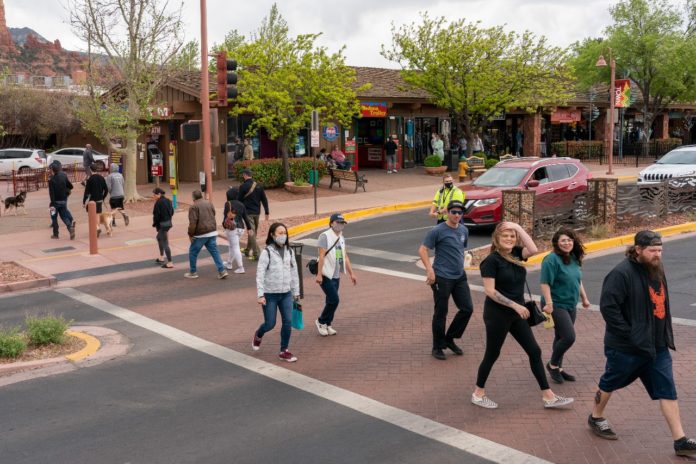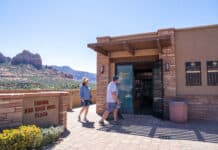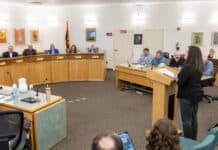
A question residents have asked for several years in regard to Sedona tourism is, “When is enough, enough?”
With the recent lifting of most COVID-19-related restrictions in Arizona, many this past six weeks have been screaming, “Enough!”
As a goodwill gesture to frustrated residents, the Sedona Lodging Council proposed a resolution at its monthly meeting on April 13 requesting that the Sedona Chamber of Commerce continue pausing direct marketing or advertising for another year. But in the end, it was met with resistance among its own members.
“We wrote this as a way to say that we understand the pressure the city council is under,” said Lodging Council President Steve Segner, who helped architect the resolution. “We also understand that everyone is a little upset.”
Segner said one of the purposes of the resolution was to give residents an insight as to what he feels is the root cause of the recent tourism increase.
“I think we need to really keep reinforcing that this problem is Gov. [Doug] Ducey’s problem,” Segner said in reference to Senate Bill 1350, which the governor supported and signed into law in 2016 allowing short-term vacation rentals statewide and prohibiting towns, cities and counties from any regulation nor oversight. “We’re here trying to fix his mess.
“I think we have to be reasonable that the city council would have a very hard time, probably, funding us this year with all the hate that seems to be going around town,” Segner said. “I wanted to say let’s be good citizens. Let’s show them that we’re not greedy and that we’re in this and that we live here. So let’s give it [city funding] up a year. And let’s tell people we’re giving it up a year. This is our way of saying we’re taking a deep breath.”
The proposed resolution states that the Sedona Lodging Council, a nonprofit organization created 18 years ago to support the needs of the Sedona area lodging industry, realizes that the past year has been very stressful and challenging for everyone living and working in Sedona.
“Once we are on the other side of this pandemic, we hope the disruption to the usual cycle of tourism will settle down to a more manageable level when it comes to traffic, trailheads and general overcrowding,” it states in part.
“We also understand that many who live in the area do not realize that in the past four years, over 2,000 new rooms and many more thousands of beds have been added to the overnight capacity of the Verde Valley — and many of these are located in houses that are now functioning as hotels,” it reads. “We cannot reverse this destructive process of converting residential communities into hotel rows because our state legislature and governor have so far refused to pass laws giving cities and counties any management authority.”
It goes on to state that neither the city, nor the Sedona Chamber of Commerce are to blame for the proliferation of short-term vacation rentals. It then states that the Lodging Council is requesting the chamber not pursue any direct marketing or advertising dollars from the city for Fiscal Year 2021-22.
“We can let the dust settle, get Sedona past the disruption from COVID, and wait until next year to see how things have changed,” the resolution states. “In the meantime, we should stay focused on any and all projects that enhance the management of visitors, such as trail maintenance, hiker transit, alternative parking arrangements, etc. Working together, the lodging industry, the city and the Chamber of Commerce can find workable solutions to our challenges.”
After the vote to decline moving forward with the resolution, Segner said he was fine with the outcome and was pleased that there was so much dialog and feedback among the Lodging Council members.
Concerns from some of the other lodging council members included that the smaller hotels and bed and breakfasts rely upon the chamber’s advertising because they don’t have as deep of pockets like some of the larger resorts or chains.
Another was — with the uncertainty of the pandemic — this could take a turn for the worse or go the opposite and greatly improve. If the latter were to occur, other destinations will catch the eye of potential travelers, both domestic and foreign, because they continue to advertise while Sedona is not. And finally, members pointed out a lot of the chamber marketing is done several months in advance and focusses on slower times of the year.
“Tourism in Sedona is at a real crossroads,” Chamber President and CEO Candace Carr Strauss said during the meeting, noting that she was not 100% onboard with the resolution. “Tourism has a bad reputation, currently. It equals traffic, trash and trailhead congestion.”
While many restrictions have been lifted in the state, she said there is still a lot of uncertainty as COVID numbers have seen a recent increase in some states such as Michigan.
Sedona, compared to many other tourist destinations, has done very well during the pandemic in terms of hotel occupancy and average daily rates, she said.
“I would rather have growth with growing pains than our businesses being shuttered, employees being laid off and our community crumbling,” Strauss said. “That is the story going on around the nation and I think we’re a little insulated and living a bit of a bubble right now and we need to look around and be a little aware of what’s going on.”
She added that the chamber and city hear the public’s concerns and understand them, and while visitation numbers have been very high this spring — which is traditionally the busiest time of the year — there are still off-peak seasons in which businesses need marketing of the area to take place. Strauss said of their 80 lodging partners, half have 40 rooms or less and often can’t afford to do their own marketing and advertising.
“We need to consider them all because not all of our children are equal in that way,” she said. “We need to make sure they are all fed.”
Segner said marketing is not just simply getting people to Sedona but rather once they are here, directing when and where to go to enjoy themselves in order to create a better visitor experience. He said even before that visitor arrives, the hotels and resorts can do a better job of giving their guests alternative options to help reduce traffic and parking issues while still having a great time.
“I think what’s happening is, people are saying, ‘Well, we just need to cut off the funding to the chamber because all they do is bring people in,’” Segner said. “That’s not true.”
Strauss later pointed out that the misconception is that all the money the city distributes to the chamber each year — currently $2.4 million — goes toward marketing and advertising.
She said the fact is that around $500,000 is used to market the area.





















